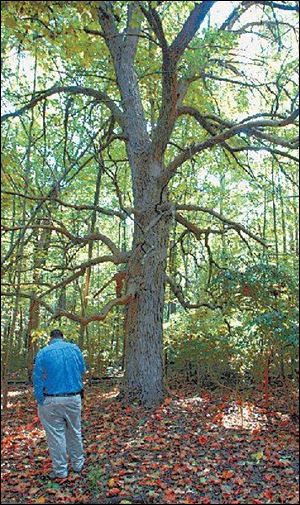
U.S. champion tree in Adrian could be in trouble
10/6/2004
Robert Gentry, superintendent of parks and forests for Adrian, believes that an attack by the ash borer on the champion tree is just a matter of time.
ADRIAN - It quietly has held the title of national champion for 20 years.
But with Asia's deadly emerald ash borer encroaching, one of Michigan's most famous ash trees soon could be in trouble.
Listed on the National Register of Big Trees as 155 feet high with an average crown diameter of 108 feet, the tree is off the beaten path and shoulder to shoulder with old maples, cottonwoods, sycamores, and box elders that are nearly as impressive.
It's in a secluded woodland down a footpath from Island Park on the city's north side, still growing strong in fertile soil. It has a remarkable shape and canopy, though city forester Robert Gentry conservatively estimates it to be about a century old. If you didn't know better, you'd swear it beats with the heart of a champion.
"It's a neat old tree," Mr. Gentry said. "For its age, it's in pretty good shape."
Ash for years has been viewed as some kind of a superhero tree. It filled the void as a shade tree for city streets after Dutch elm disease wiped out America's majestic elms. It filled a dual role by being both adaptable to many types of soil and disease-resistant. It warded off all kinds of pests, disease, and fungus, except one: the emerald ash borer.
The thumbnail-sized, metallic-green beetle is believed to have been accidentally brought to North America in wood shipments. Since first identified in
the Detroit area in 2002, it has spread to Ohio, Indiana, Ontario, Maryland, and Virginia.
It is widely seen as the No. 1 forestry pest in North America, threatening 10 billion ash trees east of the Rocky Mountains, including 3.8 billion in Ohio.
Lenawee County has it. The county is one of many under quarantine. Adrian, its county seat, is west of southeast Michigan's core infestation area, but just barely.
Adrian's champion tree shows no sign of the beetle's infestation with its lush growth at the top; trees infested by the emerald ash borer typically die from the top down. However, "it's probably just a matter of time," Mr. Gentry lamented.
The National Register of Big Trees is a list one of the nation's most venerable conservation groups, American Forests, has issued each year since 1940. The group claims to be the nation's oldest nonprofit conservation organization, dating to 1875.
Robert Smith, a retired social worker from Adrian, said he and the late Paul Thompson, formerly of the Cranbrook Institute of Science, nominated Adrian's big ash tree and a few others in 1984.
Though listed as a black ash, Mr. Smith has second-guessed its identification. So has Mr. Gentry. They now question whether it's actually another type of ash, such as a blue ash, and whether Mr. Thompson was overly generous by claiming in its application it is 155 feet. Even now, 20 years later, it appears to be somewhat less, they said.
Neither has strong feelings about whether another tree replaces it as the champion black ash someday. They said it wouldn't bother them if, in future years, it would have to compete for the blue ash title instead. The latter is held by a tree in McLean, Ill., that's 10 feet shorter and 36 feet narrower.
Their objective is simply to save any ash trees they can by reminding people to abide by quarantines and not move firewood or other ash products.
They urge cooperation, but they recognize the outlook is bleak.
"We will lose a lot of our ash trees, if not all of them. I'd like to think we can contain [the emerald ash borer], but our chances are awfully slim," Mr. Smith said.
Contact Tom Henry at:
thenry@theblade.com
or 419-724-6079.